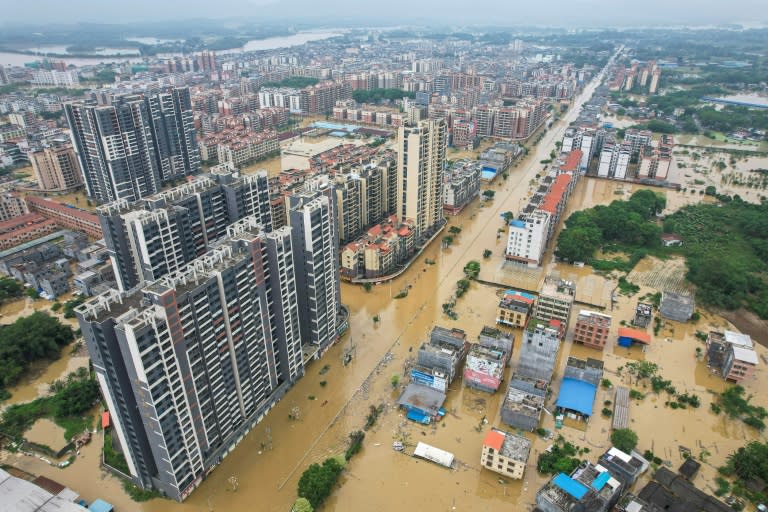China issues highest-level rainstorm warning after deadly floods

More than 100,000 people have been evacuated due to heavy rain and fatal floods in southern China, with the government issuing its highest-level rainstorm warning for the affected area on Tuesday.
Torrential rains have lashed Guangdong province in recent days, swelling rivers and raising fears of severe flooding that state media said could be of the sort only "seen around once a century".
The megacity of Shenzhen was among the areas experiencing "heavy to very heavy downpours" on Tuesday, the city's meteorological observatory said, adding the risk of flash floods was "very high".
It later downgraded its weather warning as the storms weakened, but urged residents to remain vigilant against disasters.
Images from Qingyuan -- a city in northern Guangdong that is part of the low-lying Pearl River Delta -- showed a building almost completely submerged in a flooded park next to a river.
Official media reported Sunday that more than 45,000 people had been evacuated from Qingyuan, which straddles the Bei River tributary.
State news agency Xinhua said 110,000 residents across Guangdong had been relocated since the downpours started over the weekend.
The floods have claimed the lives of four people, according to state media.
- Engulfed lampposts -
An AFP team in Qingyuan saw the Bei River running much higher than its usual level on Tuesday evening, with the water almost completely engulfing lampposts on a pedestrianised bank that had been closed to the public.
The rain stopped in the afternoon and the flood water fell slightly, allowing curious onlookers to come and look over the swollen banks.
Li Yan, 52, said he was more concerned about people living down the river than about the continued rainfall forecast for the next few days.
"Where I live there's no risk. People here are used to flooding and the water was already higher in the past," he said.
"Some areas downstream are more affected though."
A friend he video called, however, was stranded on a small island on the river because of the flooding.
"But hey," Li's friend said. "I had provisions, so it's no big deal."
- Ship sinks -
In Foshan, a city in central Guangdong, four people were missing after a ship struck a bridge in an incident that "may have been... due to the influence of flooding", Xinhua reported Tuesday, citing local authorities.
The vessel, which was carrying nearly 5,000 tonnes of rolled steel, smacked into a pillar of the Jiujiang Bridge on Monday evening, catapulting several of its 11 crew members into the water.
Seven people were rescued before the ship sank, Xinhua said.
A further 10 people were reported missing in earlier flood-related incidents.
Aerial shots from Guangdong showed landslides behind a town on the banks of a swollen river, with soldiers operating excavators to clear away the muddy debris.
Climate change driven by human-emitted greenhouse gases makes extreme weather events more frequent and intense, and China is the world's biggest emitter.
Parts of Guangdong have not seen such severe flooding so early in the year since records began in 1954, the state-run China National Radio reported.
- 'Take precautions' -
Guangdong is China's manufacturing heartland, home to around 127 million people.
"Please quickly take precautions and stay away from dangerous areas such as low-lying areas prone to flooding," authorities in Shenzhen said in issuing Tuesday's red alert.
Heavy rain is expected to continue in Shenzhen for the next two to three hours, authorities said.
China has been hit in recent years by severe floods, droughts and record heat.
That has meant that authorities are typically very quick to deploy, making casualties much lower than in previous decades.
Last September, Shenzhen experienced the heaviest rains since records began in 1952, while the nearby semi-autonomous city of Hong Kong saw its heaviest rainfall in nearly 140 years.
Asia was the world's most disaster-hit region from climate and weather hazards in 2023, the United Nations has said, with floods and storms the chief cause of casualties and economic losses.
bur-ehl-je/dhw

